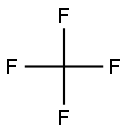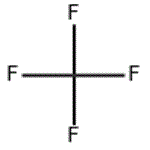
Carbon tetrafluoride
- Product NameCarbon tetrafluoride
- CAS75-73-0
- CBNumberCB6680459
-
MFCF4
Lewis structure
- MW88
- EINECS200-896-5
- MDL NumberMFCD00000371
- MOL File75-73-0.mol
- MSDS FileSDS
Chemical Properties
| Melting point | −184 °C(lit.) |
| Boiling point | −130 °C(lit.) |
| Density | (solid, -195°) 1.98; d (liq, -183°) 1.89 |
| vapor density | 3.04 (vs air) |
| refractive index | 1.1510 |
| Water Solubility | mL/100mL in H2O: 0.595 (10°C), 0.490 (20°C), 0.366 (40°C) [LAN05] |
| Merck | 13,1827 |
| Stability | Stable. Incompatible with zinc, alkaline earth metals, Group I metals, aluminium and its alloys. Non-flammable. |
| CAS DataBase Reference | 75-73-0(CAS DataBase Reference) |
| EWG's Food Scores | 1 |
| FDA UNII | 94WG9QG0JN |
| NIST Chemistry Reference | Carbon tetrafluoride(75-73-0) |
| EPA Substance Registry System | Carbon tetrafluoride (75-73-0) |
Safety
| Symbol(GHS) |

|
|||||||||
| Signal word | Warning | |||||||||
| Hazard statements | H280 | |||||||||
| Precautionary statements | P410+P403 | |||||||||
| Hazard Codes | F | |||||||||
| Safety Statements | 38 | |||||||||
| RIDADR | UN 1982 2.2 | |||||||||
| WGK Germany | 3 | |||||||||
| RTECS | FG4920000 | |||||||||
| Hazard Note | Non-flammable | |||||||||
| TSCA | T | |||||||||
| DOT Classification | 2.2 (Nonflammable gas) | |||||||||
| HazardClass | 2.2 | |||||||||
| HS Code | 2903392810 | |||||||||
| Hazardous Substances Data | 75-73-0(Hazardous Substances Data) | |||||||||
| Toxicity | LCLo inhalation in rat: 895000ppm/15M | |||||||||
| NFPA 704: |
|


